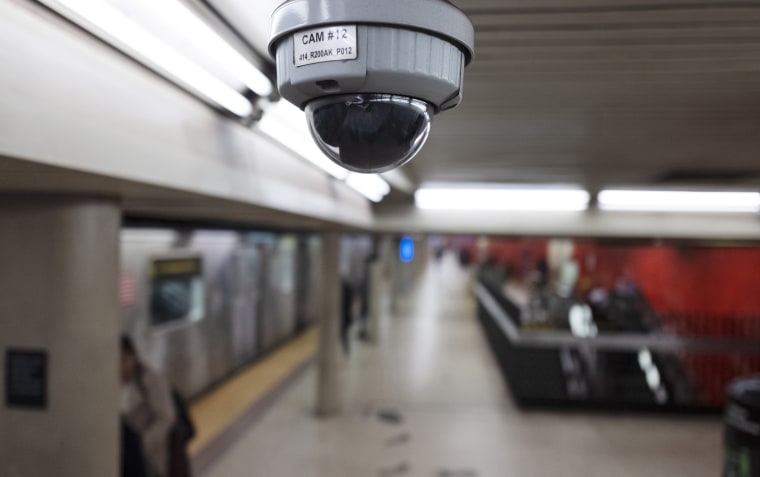Over the weekend, Americans were shocked by reports that U.S. Citizenship and Immigration Services mines state driver’s license databases with facial recognition technology to target immigrant communities. But that revelation was only the tip of the iceberg.
A massive and growing pool of surveillance data gathered by cities and states on residents within their jurisdictions makes its way to ICE every day. The information provided can range from traditional law enforcement tools — such as fingerprints, mug shots and vehicle registration data — to that gleaned from emerging types of biometric surveillance only made possible by advances in artificial intelligence, such as gait analysis identifying individuals by their movements.
Such practices put the lie to the idea that the undocumented are safe in these places — and that should scare everyone, citizens and undocumented immigrants alike.
This unregulated, local surveillance and indirect cooperation with ICE is widespread in America, even among the very localities most vocal about protecting immigrant rights, so-called sanctuary cities and states. Such practices put the lie to the idea that the undocumented are safe in these places — and that should scare everyone, citizens and undocumented immigrants alike.
The empty promise of New York City Mayor Bill de Blasio shows how far short of the reality the rhetoric of progressive officials can fall. He pledged that the city would “prevent families from being torn apart” when signing a bill solidifying New York’s status as a sanctuary city. But that didn’t change the fact that his metropolis is perhaps the most heavily monitored city in the country, regularly providing ICE with the information it needs to track down those same families.
Recently, a New York Times staffer who tweeted about yet another mechanism — a recording system that allegedly scans the faces of riders entering the Times Square subway station — asked the obvious question: “Who are you sharing the recordings with?” This is the thought that keeps me and countless other advocates up at night; not just the fact that this data is collected, but the open questions about how it’s shared with other agencies, including ICE.
The problems begin with determining just what “sanctuary cities” are supposed to be prohibiting. Some jurisdictions who have adopted the label, like Oakland, do a fairly comprehensive job of barring officials from sharing information with ICE. Others only limit when local authorities respect so-called “detainer orders,” administrative requests from ICE to jail an immigrant suspect when they would otherwise be released. Others simply interpret the phrase to mean that they won’t hold suspected undocumented immigrants on ICE’s behalf as they await their day in immigration court. Given that it’s a somewhat amorphous phrase, anywhere from dozens to hundreds of counties, cities and states have the designation depending on how it’s being defined.
So in New York, municipal employees — e.g. officers with the New York City Police Department — are prohibited from asking members of the public about their immigration status in order to minimize their chances of deportation. But even this limited restriction has never had a way to be enforced. City officials enacted a suite of reforms in 2017 to give the original law teeth, including creating the office of the Chief Privacy Officer to monitor whether agencies were adhering to their privacy obligations. But it included a massive loophole by completely exempting the NYPD.
SIGN UP FOR THE THINK WEEKLY NEWSLETTER HERE
As is the case in many other sanctuary cities, no law prohibits the NYPD from talking to ICE about the New Yorkers they are investigating. To the contrary, there are countless ways that NYPD officers are encouraged to share data, whether through Department of Homeland Security fusion centers, the High-Intensity Drug Trafficking Areas program or the Joint Terrorism Task Force.
Similarly, despite California’s promise of being a “sanctuary state,” local authorities in the town of Merced and Orange County are among the 80 local law enforcement agencies sharing automated license plate system information with ICE. In cities such as Baltimore andAustin, Texas, when officers scan a suspect’s fingerprints, they go into a database shared with the FBI and ICE. Under the Trump administration, court officers in sanctuary cities and states have worked with ICE to target witnesses and the victims of crimes.
The tools ICE buys to track our undocumented neighbors today can be turned on U.S. citizens tomorrow.
City councils and state legislatures are trying to address gaps to safeguard the promise to protect undocumented immigrants. Some cities, including Oakland, California, San Francisco and Nashville, Tennessee, have already gone further and enacted wholesale bans on the sort of facial recognition that ICE engaged in. And dozens of surveillance reform bills are pending in cities and states throughout the country, requiring the police to get civilian approval before purchasing new surveillance tools and enhancing ongoing oversight by elected officials and other independent appointees.
But there’s no guarantee these places will do any better than New York has in protecting its undocumented residents. Moreover, their failure to end information-sharing from these surveillance techniques affects the privacy of every single American. The tools ICE buys to track our undocumented neighbors today can be turned on U.S. citizens tomorrow. These databases make it cheap and easy to spy on millions of people at a time, trying to log every decision we make in public. It’s hard to imagine a future more un-American than that.

